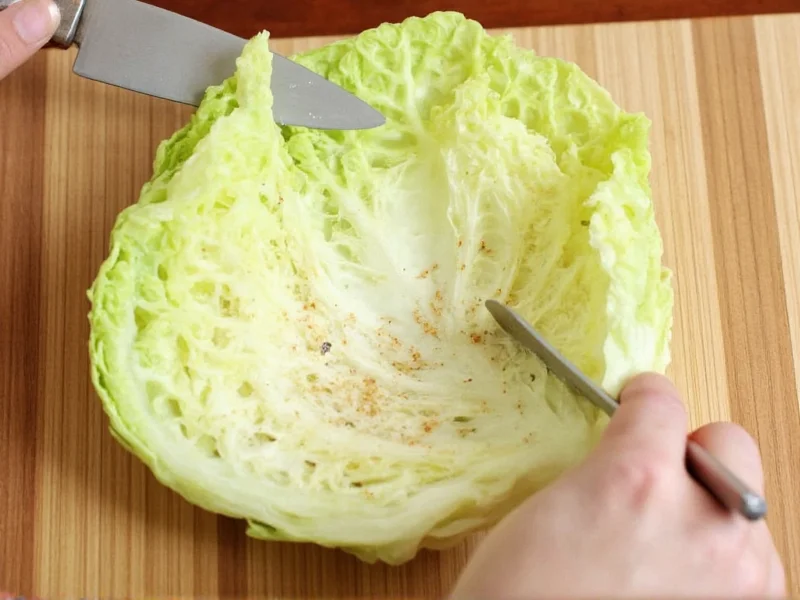Understanding how to properly season cabbage transforms this humble vegetable from bland to brilliant. Cabbage's mild, slightly sweet flavor with subtle peppery notes makes it incredibly versatile across global cuisines. The right seasoning approach depends on whether you're preparing raw, cooked, or fermented cabbage, as each preparation method affects how flavors interact with the vegetable's natural compounds.
Understanding Cabbage's Flavor Profile
Cabbage contains glucosinolates that create its characteristic mild bitterness and peppery notes when raw. When cooked, these compounds break down, revealing sweeter flavors while developing complex umami characteristics. This chemical transformation explains why different seasonings work better at various preparation stages.
Essential Seasoning Principles for Cabbage
Successful cabbage seasoning follows three key principles:
- Balance bitterness - Acidic components counteract natural bitterness
- Enhance sweetness - Complementary flavors bring out cabbage's natural sugars
- Create texture contrast - Crunchy elements offset cabbage's soft texture when cooked
| Preparation Method | Recommended Seasonings | Flavor Enhancement Ratio |
|---|---|---|
| Raw (slaws, salads) | Lemon juice, fresh dill, caraway, celery seed | 1 tbsp acid : 1 tsp herbs per 4 cups cabbage |
| Cooked (sautéed, roasted) | Garlic, smoked paprika, apple cider vinegar, caraway | 2 cloves garlic : 1 tbsp vinegar per 1 head cabbage |
| Fermented (sauerkraut) | Sea salt, juniper berries, mustard seeds | 2.5% salt by weight, 1 tsp spices per 5 lbs cabbage |
Seasoning Techniques for Different Cabbage Preparations
Raw Cabbage Seasoning Guide
For coleslaw and fresh cabbage salads, acid is crucial for both flavor and texture. The best seasoning combinations for raw cabbage include:
- Classic coleslaw blend: 3 parts mayonnaise, 1 part apple cider vinegar, 1 tbsp celery seed, 2 tbsp sugar per 4 cups shredded cabbage
- Mediterranean raw cabbage: Lemon juice, olive oil, fresh dill, garlic, and a pinch of red pepper flakes
- Asian-inspired slaw: Rice vinegar, sesame oil, ginger, and a touch of honey
Pro tip: Salt raw cabbage lightly and let it sit for 15 minutes before dressing. This draws out excess moisture and allows the cabbage to better absorb seasonings for cabbage recipes.
Cooked Cabbage Seasoning Strategies
When seasoning cooked cabbage, fat carries flavors while acids brighten the final dish. Professional chefs recommend these approaches:
- Sautéed cabbage perfection: Start with bacon fat or olive oil, add sliced onions until translucent, then cabbage with 1 tsp caraway seeds, 2 minced garlic cloves, and 2 tbsp apple cider vinegar. Cook until tender-crisp.
- Roasted cabbage enhancement: Toss cabbage wedges with olive oil, smoked paprika, garlic powder, and a drizzle of balsamic reduction before roasting at 400°F.
- Boiled cabbage transformation: Add a whole peeled potato to the cooking water to absorb bitterness, then finish with butter, lemon zest, and fresh thyme.
Fermented Cabbage Seasoning Essentials
For sauerkraut and kimchi, proper seasoning ensures both flavor and successful fermentation:
- Traditional sauerkraut: Use 2.5% non-iodized salt by weight (about 1.5 tbsp per 5 lbs cabbage), plus 1 tsp caraway seeds or juniper berries per quart jar
- Korean kimchi base: Gochugaru (Korean red pepper flakes), garlic, ginger, fish sauce, and glutinous rice paste create the ideal seasoning profile for napa cabbage
- Flavor development tip: Add fresh herbs like dill or mustard seeds after fermentation has begun (around day 3) for more complex seasoning for fermented cabbage
Regional Cabbage Seasoning Traditions
Global cuisines offer time-tested seasoning combinations worth exploring:
- Eastern European approach: Caraway seeds and vinegar balance cabbage's sweetness in dishes like bigos (hunter's stew)
- Mexican cabbage seasoning: Lime juice, cilantro, and a pinch of cumin create perfect taco toppings
- Chinese culinary tradition: Ginger, garlic, Shaoxing wine, and sesame oil enhance stir-fried cabbage
- German cabbage preparation: Apples, juniper berries, and a splash of white wine complement braised red cabbage
Common Cabbage Seasoning Mistakes to Avoid
Even experienced cooks make these seasoning errors with cabbage:
- Underseasoning - Cabbage requires more salt than you might expect due to its dense structure
- Adding acid too early - In cooked preparations, add vinegar or lemon juice in the last 5 minutes to preserve brightness
- Overlooking texture - Include crunchy elements like toasted seeds to contrast cooked cabbage's softness
- Using dried herbs for raw cabbage - Fresh herbs work significantly better with uncooked cabbage
Science Behind Cabbage Seasoning Pairings
The chemistry of seasoning cabbage effectively involves understanding how compounds interact. Isothiocyanates in cabbage (responsible for its slight heat) bind well with fat-soluble compounds found in spices like caraway and cumin. Acidic components break down pectin, improving texture while balancing bitterness. When preparing optimal seasoning for cabbage dishes, consider that:
- Sulfur compounds in garlic and onion complement cabbage's natural sulfur content
- Umami-rich ingredients like soy sauce or fish sauce enhance cooked cabbage's natural glutamates
- Caraway's limonene content specifically counteracts cabbage's bitterness
Practical Seasoning Measurements for Home Cooks
Use these foolproof ratios for perfect seasoning every time:
- Basic cooked cabbage: For 1 medium head cabbage, use 2 tbsp butter or oil, 1 small onion, 2 garlic cloves, 1 tsp caraway seeds, 2 tbsp vinegar, salt and pepper to taste
- Simple cabbage slaw: 4 cups shredded cabbage, 3 tbsp mayonnaise, 1 tbsp vinegar, 1 tsp celery seed, 1 tbsp sugar, salt to taste
- Flavorful roasted cabbage: 1 cabbage wedge, 1 tbsp olive oil, 1 tsp smoked paprika, 1 minced garlic clove, salt, and a squeeze of lemon after cooking
Remember that seasoning for cabbage isn't one-size-fits-all. Personal preference plays a role, so start with these ratios and adjust to your taste. The key is balancing cabbage's natural characteristics rather than overwhelming them.











 浙公网安备
33010002000092号
浙公网安备
33010002000092号 浙B2-20120091-4
浙B2-20120091-4